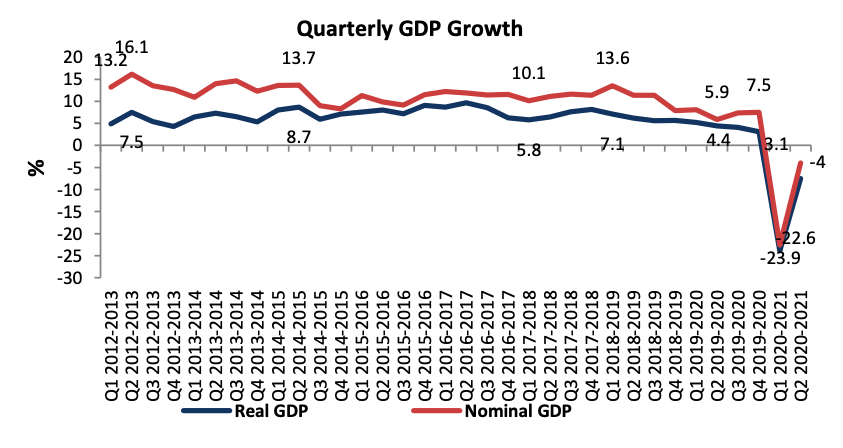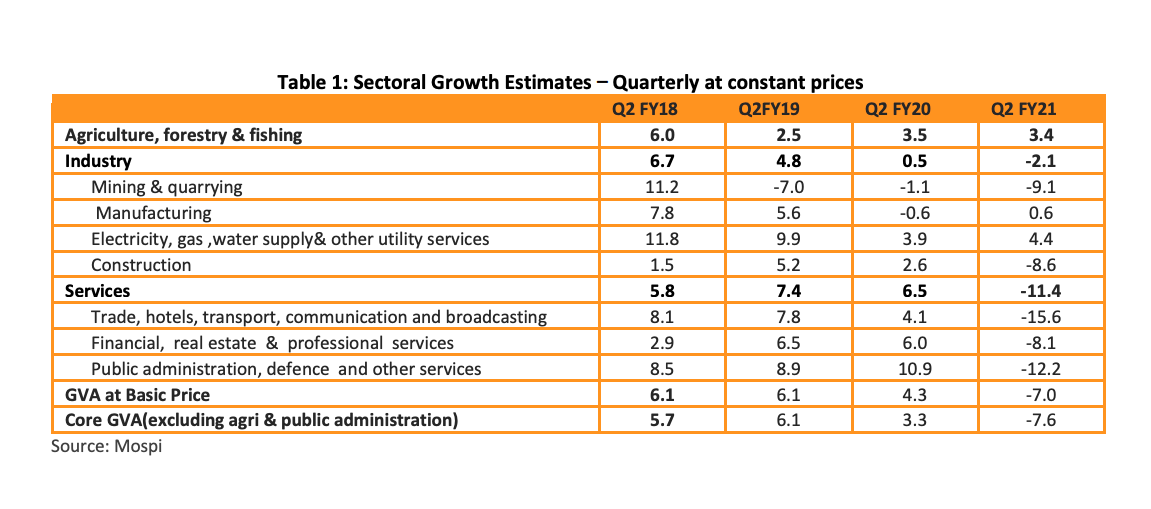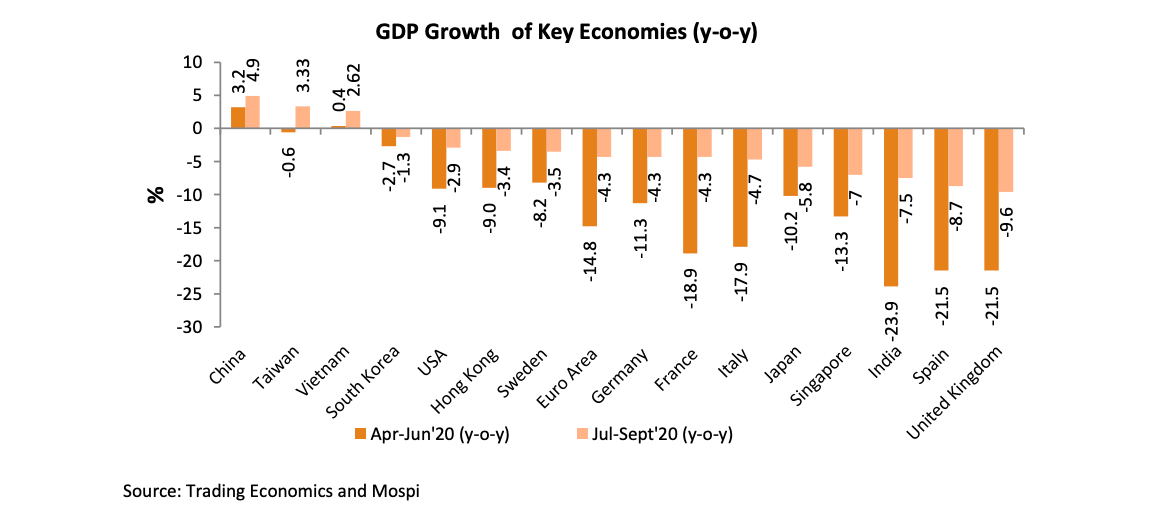GDP growth improves from Q1 washout which registered a decline of 23.9%; Consecutive two-quarters decline signals economic recession
Bengaluru, NFAPost: Amid growing impact of Covid-19 pandemic-led impact, Indian economy further contracted during the July-September period even though contraction narrowed to 7.5% compared with a massive decline of 23.9% during the first quarter of fiscal 2021. It shows the economy is on a recovery path.
The decline in contraction is primarily viewed as the government lifted Covid-related restriction and the Finance Ministry came up with various measures to give a booster dose to improve the micro and macroeconomic scenario. According to Arvian Research analyst, the economy is witnessing is a rebound in manufacturing, power generation and sustained farm output growth supporting a recovery in GDP growth.

“The better-than-expected growth in Q2 was driven primarily by pent-up demand, support from agriculture and select export sectors, cost savings for corporates and people’s “learning to live with the pandemic,” opined Arvian Research.
The National Statistical Office (NSO) release estimates GDP for the second quarter of 2020-21 at constant (2011-12) Prices is estimated at Rs 33.14 lakh crore, as against ₹ 35.84 lakh crore in Q2 of 2019-20, showing a contraction of 7.5 percent as compared to 4.4% growth in Q2 2019-20.
Quarterly gross value added (GVA) at Basic Prices at Constant (2011-12) Prices for Q2 of 2020-21 is estimated at Rs 30.49 lakh crore, as against Rs 32.78 lakh crore in Q2 of 2019-20, showing a contraction of 7.0%. GDP at Current Prices for Q2 2020-21 is estimated at Rs 47.22 lakh crore, as against Rs 49.21 lakh crore in Q2 2019-20, showing a contraction of 4.0% as compared to 5.9% growth in Q2 2019-20.
The GDP recovery is expected to continue in Q3 as the government lifts curbs on most economic activities that were imposed in March. Thee RBI said on 11 November that it now expects an economic expansion in the December quarter, earlier than it previously estimated.

At the same time, India’s growth is still lagging behind other major Asian economies such as China, which expanded 4.9% in the September quarter; Japan, which grew 5%; and Singapore, which contracted 5.8%.
It is interesting to note that the performance of the manufacturing sector which grew at 0.6% in the July-September period against an expected contraction. This should be viewed from Gross value added (GVA) in manufacturing witnessed a steep contraction of 39.3% in Q1.
Chief economic adviser in the finance ministry Krishnamurthy Subramanian said the economic data was encouraging, but cautioned that the economic trajectory hinges on how the pandemic evolves in the winter months ahead.
“My sense is that we should definitely be continuing the recovery, provided the pandemic remains in control,” Subramanian said, adding that more recent indicators in October showed that the economy clearly was in an expansionary phase.
The farm sector growth, which stayed unruffled by the lockdown in Q1, sustained the performance in Q2 too on account of improved Kharif sowing and robust and widespread monsoon. Agriculture GVA grew 3.4% in Q2, similar to the expansion seen in Q1.

According to CARE Rating analyst Kavita Chacko, the Indian economy in the July – September quarter staged an impressive recovery from the record decline of the preceding three months, suggesting that the resumption of economic activity has been gathering pace.
“Despite the improvement, the domestic economy in Q2 FY21 continued to be in contraction mode for the second successive quarter and thereby was technically in a recession. The GDP growth in Q2 FY21 at (-) 7.5% (y-o-y) was sharply lower than the 4.4% growth in Q2 FY20. At the same time, the contraction was less severe than the (-)24% fall in Q1 FY21. The GDP reading was also better than market expectations. CARE Ratings had estimated the GDP growth for the quarter at -9.9%,” states Kavita Chacko.
Consumption demand continued to be weak with private as well as government consumption registering negative growth. Investments too contracted during the quarter.
Sector-wise performance in Q2 2020-21 (year-on-year)
- Barring agriculture, manufacturing and electricity, all the other sectors witnessed a contraction in growth in Q2 FY21.
The core GVA growth, which excludes the agriculture and government sector was -7.6 % in Q2 FY21 against the -7.0% growth in overall GVA.
* Agriculture sector witnessed near stable growth at 3.4%.
* The industrial sector contracted by -2.1% in Q2 FY21 (y-o-y) which is a notable improvement from the (-) 38% growth of in Q1 FY21. The gains here were led by the manufacturing sector.
* Manufacturing sector witnessed positive growth of 0.6% in Q2 FY21 v/s the (-) 0.6% growth in Q2 FY20. The positive growth in the manufacturing sector can be attributed to the higher activity with the easing of the lockdown restricitions as well as favourable base effect.
* The construction sector improved from (-)50.3% in Q1 FY20 to (-) 8.6% in Q2 FY21.
* The trade, hotel and transport segment registered the highest contraction amongst the sectors during July-September at (-)15.6%.
* Public administration, defence and other services saw growth contracted further from 10.3% in Q1 FY21 to (-) 12.2% in Q2 FY21.
* The overall services sector registered a contraction of 11.4% in Q2 FY21 against the 6.5% growth in Q2 FY20.
The central government’s proactive intervention by coming up with Rs 30 lakh crore work of stimulus package announced at various times by the Finance Ministry helped to pull back the economy out of drastic slump. The Reserve Bank of India has cut key interest rates by 115 basis this year further helped in fuelling economic activities. RBI is reviewing the situation soon the monetary plicy again next week.
Commenting on the GDP performance, SBI Group Chief Economic Adviser Soumya Kanti Ghosh said India’s Q2FY21 GDP growth showed surprising resilience with contraction of only -7.5% in real terms, while the market consensus was higher.
“With the improvement in manufacturing, due to the lifting of lockdown measures GDP contraction has slowed down significantly. The agriculture sector continued to perform well with growth at 3.4%. Services remained in the negative territory, although the decline was contained as Trade, Hotels, Transport, Communication & Services related to broadcasting showed recovery,” said Soumya Kanti Ghosh.
One good thing is that the investment demand has improved with a resumption in COVID-induced stalled projects. However, Soumya Kanti Ghosh said the patchy growth across sector reflects in domestic demand figures, which are showing modest recovery sequentially.
“The falling imports and continued contraction in investment suggests poor domestic absorption and intermediate demand. The reading of Q2 GDP suggests that the output gap has not corrected to the point that it will be a concern for demand-pull inflation,” said Soumya Kanti Ghosh.
GDP growth although expected to improve in the remaining two quarters of 2020-21 with the improved pace of pickup in
economic activity across most sectors. The economy, however, continues to face downward pressured from the sustained spread of the pandemic in the country and the re-imposition of restrictions in various regions.
Consumption demand and investments which is necessary to propel the economy would continue to be tepid and is
unlikely to seen a noteworthy improvement during the course of the year. Analysts view that the country’s GDP to contract by -7.7% to -7.9% next quarter.





